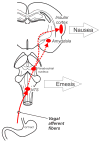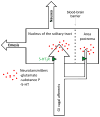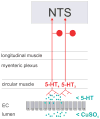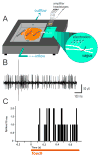Measuring the nausea-to-emesis continuum in non-human animals: refocusing on gastrointestinal vagal signaling
- PMID: 24862507
- PMCID: PMC4112147
- DOI: 10.1007/s00221-014-3985-y
Measuring the nausea-to-emesis continuum in non-human animals: refocusing on gastrointestinal vagal signaling
Abstract
Nausea and vomiting are ubiquitous as drug side effects and symptoms of disease; however, the systems that determine these responses are arguably designed for protection against food poisoning occurring at the level of the gastrointestinal (GI) tract. This basic biological pathway using GI vagal afferent communication to the brain is not well understood. Part of this lack of insight appears to be related to current experimental approaches, such as the use of experimental drugs, including systemic chemotherapy and brain penetrant agents, which activate parts of the nausea and vomiting system in potentially unnatural ways. Directly related to this issue is our ability to understand the link between nausea and vomiting, which are sometimes argued to be completely separate processes, with nausea as an unmeasurable response in animal models. An argument is made that nausea and emesis are the efferent limbs of a unified sensory input from the GI tract that is likely to be impossible to understand without more specific animal electrophysiological experimentation of vagal afferent signaling. The current paper provides a review on the use of animal models and approaches to defining the biological systems for nausea and emesis and presents a potentially testable theory on how these systems work in combination.
Figures







Similar articles
-
The medical implications of gastrointestinal vagal afferent pathways in nausea and vomiting.Curr Pharm Des. 2014;20(16):2703-12. doi: 10.2174/13816128113199990568. Curr Pharm Des. 2014. PMID: 23886386 Review.
-
Delineation of vagal emetic pathways: intragastric copper sulfate-induced emesis and viral tract tracing in musk shrews.Am J Physiol Regul Integr Comp Physiol. 2014 Mar 1;306(5):R341-51. doi: 10.1152/ajpregu.00413.2013. Epub 2014 Jan 15. Am J Physiol Regul Integr Comp Physiol. 2014. PMID: 24430885 Free PMC article.
-
The role of vagal neurocircuits in the regulation of nausea and vomiting.Eur J Pharmacol. 2014 Jan 5;722:38-47. doi: 10.1016/j.ejphar.2013.08.047. Epub 2013 Oct 31. Eur J Pharmacol. 2014. PMID: 24184670 Free PMC article. Review.
-
A genetic approach for investigating vagal sensory roles in regulation of gastrointestinal function and food intake.Auton Neurosci. 2006 Jun 30;126-127:9-29. doi: 10.1016/j.autneu.2006.03.005. Epub 2006 May 4. Auton Neurosci. 2006. PMID: 16677865 Review.
-
Food restriction, refeeding, and gastric fill fail to affect emesis in musk shrews.Am J Physiol Gastrointest Liver Physiol. 2010 Jan;298(1):G25-30. doi: 10.1152/ajpgi.00366.2009. Epub 2009 Nov 5. Am J Physiol Gastrointest Liver Physiol. 2010. PMID: 19892939 Free PMC article.
Cited by
-
Corrination of a GLP-1 Receptor Agonist for Glycemic Control without Emesis.Cell Rep. 2020 Jun 16;31(11):107768. doi: 10.1016/j.celrep.2020.107768. Cell Rep. 2020. PMID: 32553160 Free PMC article.
-
The Parabrachial Nucleus: CGRP Neurons Function as a General Alarm.Trends Neurosci. 2018 May;41(5):280-293. doi: 10.1016/j.tins.2018.03.007. Trends Neurosci. 2018. PMID: 29703377 Free PMC article. Review.
-
Central mechanisms of emesis: A role for GDF15.Neurogastroenterol Motil. 2025 Mar;37(3):e14886. doi: 10.1111/nmo.14886. Epub 2024 Aug 6. Neurogastroenterol Motil. 2025. PMID: 39108013 Free PMC article. Review.
-
Neural pathways of nausea and roles in energy balance.Curr Opin Neurobiol. 2025 Feb;90:102963. doi: 10.1016/j.conb.2024.102963. Epub 2025 Jan 6. Curr Opin Neurobiol. 2025. PMID: 39765206 Free PMC article. Review.
-
Glucagon-like peptide-1 in diabetes care: Can glycaemic control be achieved without nausea and vomiting?Br J Pharmacol. 2022 Feb;179(4):542-556. doi: 10.1111/bph.15647. Epub 2021 Sep 14. Br J Pharmacol. 2022. PMID: 34363224 Free PMC article. Review.
References
-
- Andrews PL, Davis CJ, Bingham S, Davidson HI, Hawthorn J, Maskell L. The abdominal visceral innervation and the emetic reflex: pathways, pharmacology, and plasticity. Can J Physiol Pharmacol. 1990a;68:325–345. - PubMed
-
- Andrews PLR, Bhandari P, Garland S, et al. Does retching have a function?: An experimental study in the ferret. Pharmacodynamics Therapeutics. 1990b;9:135–152.
Publication types
MeSH terms
Grants and funding
LinkOut - more resources
Full Text Sources
Other Literature Sources
Medical

